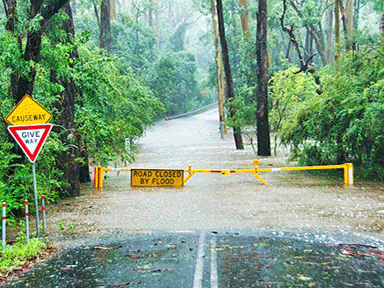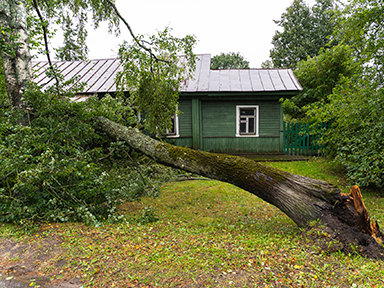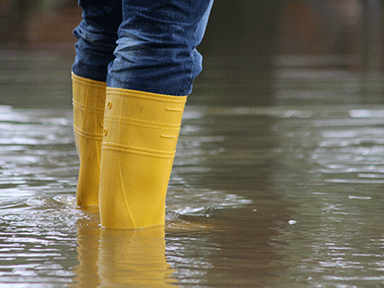The frequency and severity of natural disasters in Australia is increasing. To be on the front foot, there are things landlords can do to protect their investment. Read on to find out more.
Changing weather conditions are playing a huge part in the increase in natural disasters on Aussie shores. In fact, because of wetter, hotter, drier weather, the risk to property in susceptible areas is rising. According to Domain’s 2024 Perils Report:
-
5.6 million homes (almost half of all properties) are at risk of bushfire;
-
953,000 homes (8.1 per cent of all properties) face flood risk; and
-
around 160,000 homes are within 150 metres of the coastline and approximately one in 10 are at risk of coastal erosion.
Australians are paying the price. $38 billion – that’s how much natural disasters currently cost the Australian economy each year, on average. That figure is set to climb to at least $73 billion and potentially to $94 billion a year by 2060, according to a report from Deloitte.
With the risk of extreme weather events (and the associated costs) increasing, landlords should consider what they can do to help protect their investment property from natural disasters.
Preparing your rental
To find out the natural hazard risks at your rental, there are numerous resources to consult including your local council and emergency services.
When buying an investment property, it is important you investigate the catastrophe profile of the area and consider the associated risks.
If you are building a new rental property, disaster mitigation and resilience should be factored into construction. The National Construction Code sets out performance standards for houses built in areas that are prone to bushfires, cyclones and flooding. YourHome.gov.au outlines some considerations.
Meanwhile, if you own an established property, there are measures you can take to retrofit the premises to be more resilient. The ICA has some tips to protect against cyclones, storms, flooding, and bushfires.
The role of insurance
While modifying building design and a range of other measures can help mitigate the risk and extent of damage, insurance also has a crucial role to play.
The right insurance policy means owners can protect their investment for certain financial losses against a range of extreme weather events. A good landlord insurance policy can protect against certain natural catastrophes like bushfire, cyclones, severe wind, floods, storms and hailstorms. It should be noted, cases of coastal erosion where the problem develops over time which are not directly resulting from an insured event are not covered.
When considering insurance, check that your policy includes cover for the extreme weather events and natural disasters that are likely to impact your property.
You should be aware that not all insurers cover all natural catastrophe risks. Some risks may be completely excluded, such as loss or damage caused by an act of the sea. Other risks may be optional extras for which you pay a higher premium. For example, flood cover is an add-on in many insurance policies. NOTE: EBM RentCover policies automatically include flood cover; however, we may not offer cover for properties in certain high-risk flood areas.
It is important that you know what risks your rental property potentially faces, and also whether the insurance policy you are considering provides for those risks and the conditions of that cover.
Be sure to familiarise yourself with the terms and conditions of the policy so that you understand which events are covered. For example, some insurers will treat damage resulting from riverine flooding differently to surface water flooding. Also check the coverage as it relates to the damage caused by an event. As an example, while bushfire is generally covered, loss or damage to any item caused by scorching, melting, or charring without flames may not be.
Climate change and insurance
In recent years, the debate about climate change and insurance has heated up. The increasing frequency and severity of extreme weather events is seeing damage costs escalate. This, in turn, has impacted the availability and cost of property insurance.
The Climate Council’s Uninsurable Nation report notes that insurance will become increasingly unaffordable or unavailable in large parts of Australia due to worsening extreme weather.
Governments, agencies, the building industry, communities and the insurance industry among others are working to address the availability and affordability issue by exploring various options including development and planning considerations, resilience mitigations and measures, and insurance matters such as reinsurance pools.
While work continues to address the issues, insurers are making coverage decisions based on the economic realities of providing insurance for high-risk properties. This means some insurers no longer offer cover for property in high-risk flood or cyclone areas, while others have revised their coverage, including the premiums.
Takeaway
As Australia’s weather changes, owners will need to improve climate resilience of their properties, and generally find ways to mitigate against the loss and damage caused by these events. One important solution is having the right insurance policy in place – one that provides financial protection against threats like bushfire, cyclones, flood and storm.
If you have questions about how EBM RentCover landlord insurance policies respond to natural disasters, please get in touch with a member of our Expert Care team – 1800 661 662.
*While we have taken care to ensure the information above is true and correct at the time of publication, changes in circumstances and legislation after the displayed date may impact the accuracy of this article. If you need us we are here, contact 1800 661 662 if you have any questions.
You may also like
View all
Flood events are a seasonal reality and will continue in the future. What does this mean for insurance?

Here’s what you need to know about cyclones and insurance, and a few tips to cyclone-proof your investment property...

We highlight five of Australia’s costliest natural disasters and how they changed insurance cover...



